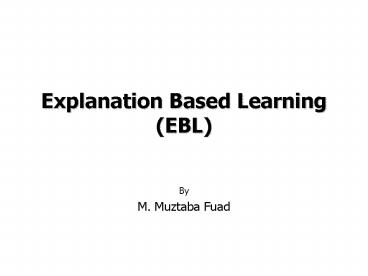Explanation Based Learning EBL - PowerPoint PPT Presentation
1 / 11
Title:
Explanation Based Learning EBL
Description:
Sees(x,y) Habile(x) Fixes(x,y) // A habil individual that can see another entity ... R2D2(x) Habile(x) // R2D2-class in individuals are habil. Facts: Robot(Num5) ... – PowerPoint PPT presentation
Number of Views:780
Avg rating:3.0/5.0
Title: Explanation Based Learning EBL
1
Explanation Based Learning(EBL)
- By
- M. Muztaba Fuad
2
What is EBL ?
- Learning general problem-solving techniques by
observing and analyzing human solutions to
specific problems. - EBL attempts to formulate a generalization after
observing only a single example. - Introduced by Gerald De Jong in 1981.
3
The EBL Hypothesis
- EBL is based on the hypothesis that an
intelligent system can learn a general concept
after observing only a single example. - By understanding why an example is a member of a
concept, can learn the essential properties of
the concept. - EBL uses prior knowledge to analyze or explain
each training example in order to infer what
properties are relevant to the target function
and which are irrelevant.
4
Learning by Generalizing Explanations
- Given
- Goal concept (e.g., some predicate calculus
statement) - Training example (facts)
- Domain Theory (inference rules)
- Operationality Criterion
- Given this four inputs, the task is to determine
a generalization of the training example that is
sufficient concept definition for the goal
concept and that satisfies the operationality
criteria. - The operationality criterion requires that the
final concept definition be described in terms of
the predicates used to describe the training
example.
5
Standard Approach to EBL
6
The EBL Process
7
An Example
- Domain theory
- Fixes(u,u)? Robust(u) // An individual that can
fix itself is robust - Sees(x,y) ? Habile(x) ?Fixes(x,y) // A habil
individual that can see another entity can
// fix that entity - Robot(w) ?Sees(w,w) // All robots can see
themselves - R2D2(x) ? Habile(x) // R2D2-class in individuals
are habil - Facts
- Robot(Num5)
- R2D2(Num5)
- Age(Num5,5)
- Goal
- Robust(Num5)
8
An Example (continued)
Generalization
Explain
- Robot(r) ? R2D2(r) ?Robust(r)
9
History ??
- EBL may be viewed as a convergence of several
distinct lines of research within machine
learning. - EBL has developed out of efforts to address each
of the following problems - Justified generalization.
- Chunking.
- Operationalization.
- Justified analogy.
10
Recommended Reading
- Mitchell T.M., Keller R.M., Kedar-Cabelli S.T.,
Explanation-Based Generalization A Unifying
View, Machine Learning 1, pp. 47-80, 1986, Kluwer
Academic Publishing. - DeJong G., Mooney R., Explanation-Based Learning
An Alternative View, Machine Learning 1, 1986,
Kluwer Academic Publishing. - Ellman, T, Explanation-Based Learning A Survey
of Programs and Perspectives, ACM Computing
Survayeys, Vol. 21, No. 2, 1989. - Available online at
- ACM Digital Library or
- http//citeseer.nj.nec.com/cs
11
Conclusions
- Explanation Based Learning (EBL)
- Needs only one example.
- Requires complete knowledge about the concept.
- Shows the importance of prior knowledge in
learning.

